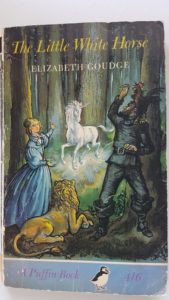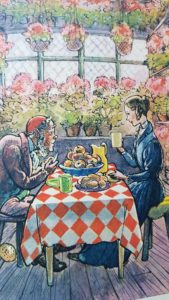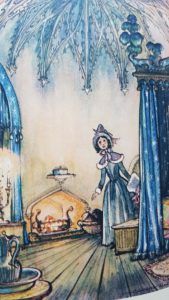The world out there seems so broken and divided and ugly and violent. Is it bothering me more than usual because it’s nearly Christmas? In the West, anyway, isn’t it the time of love and peace, over-eating and gifts? I’m trying to avoid the news but it’s hard to do.
I was feeling in need of comfort yesterday, and so I turned to childhood and “The Little White Horse” by Elizabeth Goudge.  My old Puffin copy has been so well-loved that it’s falling apart and, when I opened it I found I’d used as a bookmark one of the deckle-edged little thank-you cards we had printed in early 2002 after my father’s funeral. Oh, dear. It was a difficult time. Apart from the obvious – my beloved Dad had just died – my husband had pneumonia, my grieving mother was in poor health (so many times in that first year I thought we would lose her) and I had a job to get to and a house to run and a child just starting school. I’m not naturally a stoic (and as I often say, ‘nobody likes a martyr’), but I scarcely cried as I carried on. No wonder I turned to The Little White Horse for comfort.
My old Puffin copy has been so well-loved that it’s falling apart and, when I opened it I found I’d used as a bookmark one of the deckle-edged little thank-you cards we had printed in early 2002 after my father’s funeral. Oh, dear. It was a difficult time. Apart from the obvious – my beloved Dad had just died – my husband had pneumonia, my grieving mother was in poor health (so many times in that first year I thought we would lose her) and I had a job to get to and a house to run and a child just starting school. I’m not naturally a stoic (and as I often say, ‘nobody likes a martyr’), but I scarcely cried as I carried on. No wonder I turned to The Little White Horse for comfort.
The novel starts in Gothic novel territory, with 13-year-old orphan Maria, her governess Miss Heliotrope and her Cavalier King Charles spaniel Wiggins in a dilapidated carriage bumping though a dark and cold night. They’re going to live with her uncle in his ancient manor house. They’ve never met him before. Moonacre Manor is in the depths of unknown country…
But instead of heading into the dark and dangerous, the story swerves into the joyous, delightful and magical. Maria is an enchanting heroine; fastidious, clever, loving and loyal, sensible and brave. (And somewhat vain, with a relatable love of clothes and pretty things). But she’s not passive. She’s up for action and adventure, willing to challenge the adults, fight for what is right and even, occasionally, to get dirty. There’s Maria’s dream playmate Robin who turns out to be a real boy, a quartet of protective animals who keep her safe on her adventures and two bittersweet romances from the past that end in middle-aged marriages. She goes on a quest to right old wrongs, is haunted by the vision of a little white horse and manages an earthy, joyous ending with reconciliations and forgiveness and lots of tea and cake all round.
 Ah, cake! I always loved the food in this book. It’s quite a feature. Not only afternoon tea, but breakfast, lunch, dinner and various other incidental comestibles are provided by Moonacre’s astonishing cook, Marmaduke Scarlet.
Ah, cake! I always loved the food in this book. It’s quite a feature. Not only afternoon tea, but breakfast, lunch, dinner and various other incidental comestibles are provided by Moonacre’s astonishing cook, Marmaduke Scarlet.
…home-made crusty bread, hot onion soup, delicious rabbit stew, baked apples in a silver dish, honey, butter the colour of marigolds, a big jug of warm mulled claret and hot roasted chestnuts folded in a napkin.
And then there are the houses – Moonacre itself, Old Parson’s vicarage and Loveday Minette’s little cave-house. You could almost draw house-plans, they are described with such precision. Many of the rooms are lovely, but…ah, Maria’s bedroom! I imagine most little girl readers wished it was their own. I certainly did.
It’s at the top of a tower, with a door too small for all but the tiniest of adults.
The ceiling was vaulted, and delicate ribbings of stone curved over Maria’s head like the branches of a tree, meeting at the highest point of the ceiling in a carved representation of a sickle moon surrounded by stars.
branches of a tree, meeting at the highest point of the ceiling in a carved representation of a sickle moon surrounded by stars.
There was no carpet upon the silvery-oak floor, but a little white sheepskin lay beside the bed, so that Maria’s bare toes should meet something warm and soft when they went floorwards in the morning. The bed was a little four-poster, hung with pale-blue silk curtains embroidered with silver stars, of the same material as the window curtains, and spread with a patchwork quilt made of exquisite squares of velvet and silk of all colours of the rainbow, gay and lovely.
Plates and glasses, furniture, fabrics, pots and pans; dresses and coats and breeches and shoes; everything is gleaming and shining with cleanliness and care and described in caressing detail. Except for the nasty, gloomy Norman keep of the wicked Black Men, who live with their leader Monsieur Cocq de Noir and lead a bachelor existence in the pine forest. But even they change their ways, forsake wickedness, smarten up and do right.
Elisabeth Goudge published The Little White Horse in 1946, right after the end of WWII. The social history of immediate post-war Britain has long been an interest of mine and everything I’ve read would indicate that in 1946 the country was on its knees, in spite of victory. Bombed towns, rationing, shortages of everything – food, fuel, building materials – meant everyday life would have been challenging. Or downright miserable. Demobbed servicemen and women returned to ordinary life…but that could not erase the individual and collective trauma of the war years. Destroyed homes and communities and families. Children who were evacuated to live, often, with complete strangers, for years. And there were so many deaths to mourn.
I haven’t read much about Goudge’s life, but I do know that depression and ‘nervous breakdowns’ were an issue for her. I can easily imagine this book was written as a wonderful warming, comforting ‘God’s in his heaven and all’s right with the world’ wish-fulfillment fantasy. It won the Carnegie Medal in 1946. I hope it soothed her heart, even if – with the rationing of sugar, butter, eggs and flour – she could not indulge in Marmaduke Scarlet’s full catalogue of delights:
…plum cake, saffron cake, cherry cake, iced fairy cakes, eclairs, gingerbread, meringues, syllabub, almond fingers, rock cakes, chocolate cake, parkin, cream horns, Devonshire splits, Cornish pasty, jam sandwiches, lemon-curd sandwiches, lettuce sandwiches cinnamon toast and honey toast…
(I’ve taken the pictures of Walter Hodges’ colour illustrations from a 1949 edition I picked up at an opportunity shop.)

I’ve never seen those delightful pictures, but they are perfect. I certainly wished with all my heart for Maria’s bedroom, though I think these days I might choose her little parlour, a place for reading and knitting and jigsaws 🙂
The Little White Horse is a touchstone book for me, and like you, I find it a source of deep comfort.